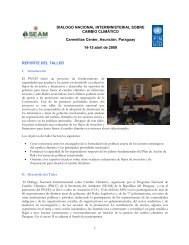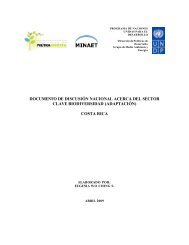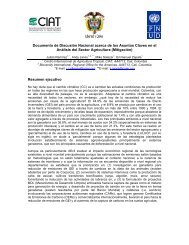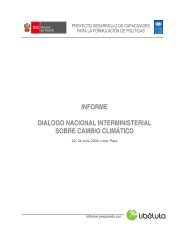View Publication - UNDPCC.org
View Publication - UNDPCC.org
View Publication - UNDPCC.org
Create successful ePaper yourself
Turn your PDF publications into a flip-book with our unique Google optimized e-Paper software.
ICTSD Programme on IPRs and Sustainable Development<br />
8<br />
to promote a de facto standard (one that is<br />
not defined by a standards <strong>org</strong>anization).<br />
• Open licensing: This is a public commitment<br />
by a party or parties owning<br />
patents or other IP to license to other<br />
parties. The owner of the patents may<br />
publish technical information or patent<br />
text on a website stating that it is<br />
“open” (public), but not necessarily<br />
“open” (free) or “open” (permitted to<br />
be used and modified without consent).<br />
<strong>View</strong>ers of the published material may<br />
be invited to use it for research purposes,<br />
but they agree in an electronic<br />
licence not to use it for commercial<br />
purposes without consent. At the time<br />
the user seeks consent, when it may<br />
have invested in developing the “open”<br />
licensed material, the owner negotiates<br />
financial terms and so may have strong<br />
bargaining power.<br />
• Dedicated patents: Some companies<br />
agree to contribute patents to a broad<br />
low-royalty or royalty-free licensing programme.<br />
This may be because the company<br />
has decided not to commercialize the<br />
technology or it may be part of a strategy<br />
to diffuse a base technology widely<br />
in order to commercialize a related<br />
technology (“give away the razors and<br />
sell the razor blades”). An example of<br />
this was Apple’s decision in the early<br />
1990s to license QuickTime technology<br />
without royalties in order to spread the<br />
technology as a platform for multimedia<br />
applications. Patent dedication may also<br />
be part of a public relations activity to<br />
demonstrate charitable commitment.<br />
2.3.2 Examples of patent pools in the<br />
information technology sector<br />
The five different examples described below<br />
illustrate the wide variety of patent pools and<br />
their objectives and some of the problems<br />
they raise.<br />
In the world of semiconductor and computer<br />
hardware technology, a number of patent pools<br />
were created in the late 1980s to promote IEEE<br />
standards (and continue today as FireWire, USB<br />
and other standards). The most well-known of<br />
these were bus and semiconductor architecture<br />
standards, where Intel was a major player and<br />
dominated the semiconductor world with its<br />
patents and royalty demands. 32 In the USA, the<br />
Federal Trade Commission began to develop<br />
law on what was good and what was bad about<br />
pools. The good was that the standard and<br />
the pool cleared the way for products from<br />
different companies to work together with<br />
a minimum of IP litigation risk. The bad was<br />
that pools and standards could strengthen the<br />
position of a company owning many patents<br />
either because smaller companies had no<br />
choice but to sign up and pay, because they had<br />
to dedicate their patents to stronger powers,<br />
or because patents that were not covered by<br />
the standard but related to it (“non-core”)<br />
ended up being licensed. 33<br />
In the world of digital signals, the Moving<br />
Pictures Expert Group (MPEG) developed an<br />
international standard beginning in 1988 and<br />
evolving in various versions through to the<br />
present. In January 2009, it was announced that<br />
a private licensing entity called Via Licensing<br />
would manage the patent pool for MPEG-4<br />
Scalable to Lossless (SLS) coding. Licensors<br />
offering their essential SLS patents include<br />
A*STAR Exploit Technologies Pte Ltd (Singapore),<br />
Fraunhofer IIS (Germany) and Nippon Telegraph<br />
and Telephone Corporation (Japan). The objective<br />
of this pool was described as follows: “More<br />
people using SLS technology will increase its<br />
value”. 34 In other words, the pool is intended<br />
to promote a technical standard and spread<br />
the technology.<br />
In the world of telecommunications, the<br />
3rd Generation Partnership Project (3GPP)<br />
was established in 1998 by several telecommunications<br />
standard development <strong>org</strong>anizations<br />
to make a global mobile phone

















